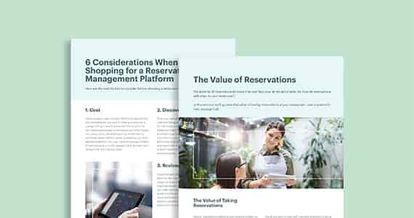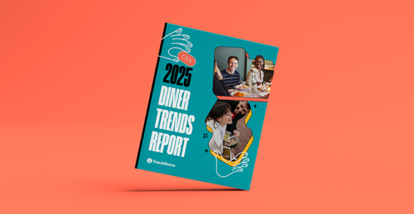You’ve gone through the painstaking process of starting a restaurant. You’ve chosen a concept, researched the market, found a location, created a menu, sourced equipment, and hired staff.
As your grand opening nears, it hits you – you need to create some buzz. While there are many ways to create hype, hosting a restaurant soft opening may just be the best way.
“But what is a soft opening? And why should I even care?”
We’re glad you asked.
Read on to learn everything you need to know about a restaurant soft opening:
- What it is and why you need one
- When to have one
- How to properly prepare
Ready? Let’s get started.

Nervous to open your doors? Make sure to check everything off this soft opening checklist for opening success!
What Is a Soft Opening?
Unlike a grand opening – the day your doors open to the public – a soft opening or soft launch happens days or weeks before. It’s the trial run for your operations, made up of an invite-only event or events. You open your doors to a limited number of people to test various elements (like your menu, service, or logistics) and iron out any kinks before opening day.
A soft launch is not a requirement for all restaurants, but there are major benefits to them.

Here are five compelling reasons to host one:
1. Build Buzz
Imagine you are opening a bar in NYC and 30 people attend your soft launch and love it. These people tell their friends, who tell their friends.
Slowly but surely, 30 people who know about your bar becomes sixty. Sixty becomes one hundred and twenty. One hundred and twenty becomes two hundred and forty.
Buzz builds, and on the grand opening day you have a queue of customers at your doors! This is the power of a successful soft launch.
2. Prepare Your Staff
The front and back of house can test their skills, and you can assess what they need to improve. Ask yourself: Is the kitchen running as it should? Do servers have the proper menu knowledge?
3. Refine Restaurant Logistics
A soft opening gives you a chance to tweak the logistics of your restaurant. For example, does your layout accommodate a full house of people walking around?
4. Get Feedback Early
A soft launch is an ideal time to obtain constructive feedback from guests. Create a survey using our downloadable restaurant survey template, and ask them what they thought about your concept, menu, and service. With timely adjustments, you can improve the restaurant experience before your grand opening! You can also repay these guests for their valuable feedback down the line through different customer appreciation ideas.
5. Boost Revenue
Many customers who enjoyed the experience may return later, and you’ll also likely get several new customers through word of mouth advertising – all of which leads to more revenue and profits.

Nervous to open your doors? Make sure to check everything off this soft opening checklist for opening success!
When Should You Host a Soft Launch?
Your soft launch date is usually set with your opening date in mind. Because hype quickly dies down after the soft opening, you don’t want a huge gap between your soft and grand opening – anywhere from a few days to a week in between is a good marker.
This way, if any major findings come from the soft opening, you have time to act on them.
How Do I Prepare for a Soft Launch?
There’s no one-size-fits-all strategy to plan and execute a soft launch, as no one restaurant is the same.
But there are common elements any restaurant will need to focus on to prepare for the soft launch, including menu, pricing, time frame, and guests.
As you work your way through this next section, consider creating a rough timeline for execution to help you remain on track. For example, plan your menu six weeks before the soft launch and send out invites four weeks before.

Nervous to open your doors? Make sure to check everything off this soft opening checklist for opening success!
Plan Your Menu
An excellent place to start your menu planning is to answer these five questions:
- Will we have a full or limited menu?
- Will we offer our menu over multiple days?
- What will we serve?
- How many portions will we make?
- What are our signature dishes?
As you work through this planning phase, you can choose between a full or limited menu.
Limited Menu:
Most people understand that a soft launch is a dress rehearsal for the official launch, which means they’re quite content with a smaller menu.
With a smaller menu, you can focus on providing an exceptional experience for that group as opposed to an average experience for many. The more food you have to make and serve, the higher the chances of mistakes in both the kitchen and front of house.
This does mean you need to carefully choose your dishes, make them to perfection, and offer stellar customer service.
Regardless of what you decide, make sure your customers know it’s a test menu.
Full Menu:
Offering a full menu is common for many restaurants that prefer to have their soft opening close to the official launch. Although this strategy helps you hit the road running, it’s not without its downfalls.
Firstly, there are more elements to manage, which causes stress and errors. Secondly, it’s easy to create an average dining experience when you’re trying to do so much. Finally, it’s harder to pinpoint problem areas when you’re testing so many elements.
2. Select a Time Frame
Your soft opening can be one main event or several that span anywhere from a few days to a couple of weeks.
The length of your soft launch, though, will ultimately depend on many factors, like your budget or opening timelines. Generally speaking, the smaller your budget, the shorter your soft launch.

Nervous to open your doors? Make sure to check everything off this soft opening checklist for opening success!
3. Choose Your Pricing Strategy
Once you’ve planned your menu and chosen a time frame, it’s time to price your menu items. Here are three options:
- Free: This is the most expensive option for you, but it builds goodwill among your customers. With this option, your staff probably won’t get tips, so you’ll likely also have to pay them more than usual. Consider this pricing option if you plan on having one main event, because it can become costly if you’re offering free food multiple times.
- Full Price: Although this is the least expensive option for you, it won’t warm new customers to your venue. On the upside, it does let customers know exactly how much they can expect to pay from day one, so there aren’t any surprises later. If you plan to charge full price, offer some freebies to thank guests for their support.
- Discounted: The discounted pricing option is a nice middle ground between free and full price that spreads the cost among you and the customer. It’s a fantastic way to build goodwill and gather customer feedback without breaking the bank.

4. Building Your Guest List
With your pricing set, you can now create your guest list. But who should you invite?
Family and Friends
Restaurateurs invite friends and family for many reasons:
- Family and friends are more forgiving of mistakes
- You can easily follow up with them to get constructive feedback becauseas you have their details
- They’re far more likely to become brand ambassadors
But take note – family and friends may find it difficult to give constructive feedback because they don’t want to hurt your feelings. Encourage them to be honest and explain it’s crucial to the overall success of your restaurant.
Local Businesses
It’s fairly common to invite local businesses to your soft opening. An easy commute means they’re more likely to come!
Here are some other great reasons to invite local businesses:
- Build a sense of community in your new neighborhood
- Get the chance to impress diners you know will be around your restaurant regularly
- Make it easier to partner with your neighbors for potential co-marketing campaigns in the future – build those relationships now!
Influencers
Here are advantages to inviting influencers:
- Receive a positive written review if they love your concept
- Generate massive buzz if an influencer mentions you
- Get constructive feedback without you having to ask for it
Of course, there are downsides – influencers are generally less forgiving, which puts enormous pressure on your staff not to slip up. And if things don’t go according to plan, you need to be prepared for a negative review.
Sending Invites: What to Include
From influencers to family, here’s what to include in the invites:
- Time, date, and address
- Dress code
- Menu pricing
- Where to RSVP
Ensure you give attendees enough advance notice to prepare for the event and so that attendance is high. Send a late notice, and you’ll likely discover many of your guests already have other plans. Send out invites no later than four weeks before the soft launch.
Sending Your Invites and Beyond
In the build-up to the soft launch, do the following to help ensure the day is a success:
- Train your servers to communicate and serve guests properly
- Let staff practice, prepare, and refine the various dishes to ensure they’re perfect
- Test your POS system
- Review your seating arrangements – nobody wants to stand!

Nervous to open your doors? Make sure to check everything off this soft opening checklist for opening success!
You’re Ready!
With your menu planned, pricing complete, invites sent, and final prep work done, you’re ready for the soft launch. You now just have to execute on the day.
Remember that the primary purpose of a soft launch is to test specific element and fix problems.
Make sure you have a system in place for collecting constructive feedback from guests on the day. Hand out a questionnaire at the end of the evening or have an informal discussion where you ask for feedback.
In either case, make sure you get the feedback soon after the event so it can be applied to your grand opening!
Hosting a soft launch offers many benefits for your restaurant. Not only does it help you build anticipation before the grand opening, but a soft opening gives your team a practice run and lets you pinpoint problems. From there, it’s just minor tweaks to ensure success on grand opening day!
Of course, to achieve these benefits in the first place, you need to prepare. This involves a laser focus on key elements: your menu, pricing strategy, and guest list. Concentrate on those and you’ll be that much closer to hosting a successful soft launch.
Free Restaurant Cleaning Checklist
Sign up for our free weekly TouchBistro Newsletter







